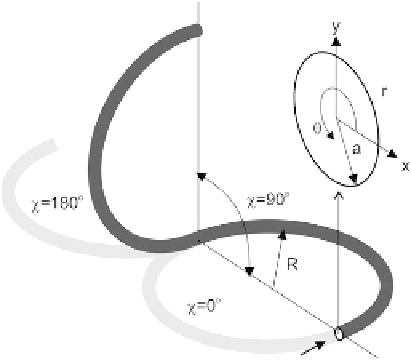Biomedical Engineering Reference
In-Depth Information
FIGURE 2.23
The basic unit of a twisted pipe consisting of two C-shaped sections.
vortices in the transverse cross-sectional plane can move fluid particles between the center of the
channel and its wall. A unit of the simplest configuration for chaotic advection is depicted in
Fig. 2.23
. The secondary flow in a twisted pipe causes the so-called Dean vortices. Fluid particles
rotate with an angle of
c
between successive units. The following analysis was reported by Jones
et al.
[32]
.
Using the polar coordinate system (
q
,
r
) in the transverse
x-y
plane, the stream function
j
and the
axial velocity
u
are determined through the following dimensionless equation system:
8
<
vj
vr
vu
vq
vj
vq
vw
vr
1
r
2
u ¼
V
C
vj
vr
2De
2
u
sin
q
r
(2.114)
:
1
r
v
vq
vj
vq
v
vr
vu
vq
cos
q
vu
vr
2
j
2
j
V
¼
V
þ
;
where De is the Dean number,
a
is the pipe radius, and
R
is the radius of curvature of the C-shape bend.
The Dean number describes the ratio between the centrifugal force and the viscous force. From
(2.109)
, the Dean number is proportional to the Reynolds number. The dimensionless pressure gradient
is defined as:
a
2
Rum
vp
vq
;
C ¼
(2.115)
where
u
is the average axial velocity. In
(
2.114)
, the lengths and velocities are normalized by the pipe
radius
a
and the average axial velocity
u
, respectively.










Search WWH ::

Custom Search